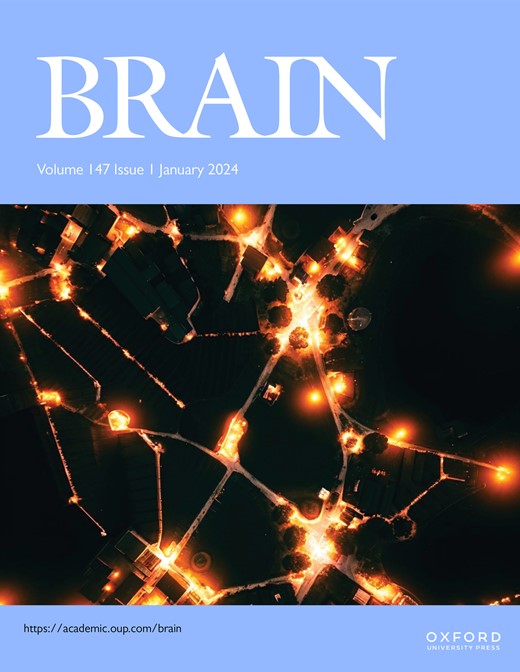Artificial intelligence models using F-wave responses predict amyotrophic lateral sclerosis
IF 10.6
1区 医学
Q1 CLINICAL NEUROLOGY
引用次数: 0
Abstract
Nerve conduction F-wave studies contain critical information about subclinical motor dysfunction which may be used to diagnose patients with amyotrophic lateral sclerosis (ALS). However, F-wave responses are highly variable in morphology, making waveform interpretation challenging. Artificial Intelligence techniques can extract time-frequency features to provide new insights into ALS diagnosis and prognosis. A retrospective analysis was performed on F-wave responses from 46,802 patients. Discrete wavelet transforms were applied to time-series waveform responses after stimulating ulnar, median, fibular, and tibial nerves. Wavelet coefficient statistics, onset age, sex, and BMI were features for training a Gradient Boosting Machine model on 40,095 (5,329 diagnosed with motor neuron disease). Model performance was tested on responses from 689 ALS patients meeting Gold Coast criteria and 689 age- and sex-matched controls. An exploratory analysis examined model performance on cohorts of patients with inclusion body myositis (IBM), cervical radiculopathy, lumbar radiculopathy, or peripheral neuropathy which can mimic ALS symptoms. Factors affecting survival were estimated through cox proportional hazards regression. The model trained using wavelet-features on the full waveform had 90% recall, 87% precision, and 88% accuracy. Similar model performance was measured using features only from the M-Wave or F-Wave. Classification probabilities for ALS patients were statistically different from the diagnoses mimicking ALS symptoms (p<0.001, ANOVA, Tukey’s post-hoc), Higher model classification probabilities of ALS, older age at onset, and family history of ALS alone or with frontotemporal dementia were factors decreasing survival. Longer diagnostic delay and upper limb onset site were factors increasing survival. Model scores two standard deviations below the mean had 4 months increased survival (two standard deviations below had 3 months decreased survival). Artificial intelligence techniques extracted important information from F-wave responses to estimate a patient’s likelihood of ALS and their survival risks. Although the model can make predictions at specific decision threshold as presented here, the true strength of such a model lies in its ability to provide probabilities about whether a patient is likely to have ALS compared to other mimicking diagnoses such as IBM, cervical or lumbar radiculopathy, or peripheral neuropathy. These probabilities provide clinicians with additional information they can use to make the final diagnosis with greater confidence and precision. Integrating such a model into the clinical workflow could help clinicians diagnose ALS sooner and manage treatment based on estimated survival, which may improve outcomes and patients’ quality of life.使用f波反应的人工智能模型预测肌萎缩侧索硬化症
神经传导 F 波研究包含亚临床运动功能障碍的重要信息,可用于诊断肌萎缩侧索硬化症(ALS)患者。然而,F 波反应在形态上变化很大,因此波形解读具有挑战性。人工智能技术可以提取时间频率特性,为肌萎缩侧索硬化症的诊断和预后提供新的见解。我们对 46802 名患者的 F 波反应进行了回顾性分析。在刺激尺神经、正中神经、腓神经和胫神经后,对时间序列波形响应进行离散小波变换。小波系数统计、发病年龄、性别和体重指数是对 40,095 人(5,329 人确诊为运动神经元疾病)进行梯度提升机模型训练的特征。对 689 名符合黄金海岸标准的 ALS 患者和 689 名年龄和性别匹配的对照者的反应进行了模型性能测试。一项探索性分析检验了模型在患有包涵体肌炎 (IBM)、颈椎病、腰椎病或周围神经病变(可模仿 ALS 症状)的患者群中的表现。影响存活率的因素通过 cox 比例危险回归进行估计。使用完整波形的小波特征训练的模型具有 90% 的召回率、87% 的精确率和 88% 的准确率。仅使用 M 波或 F 波的特征也能测出类似的模型性能。ALS患者的分类概率与模仿ALS症状的诊断结果存在统计学差异(p<0.001,方差分析,Tukey's post-hoc),较高的ALS模型分类概率、较高的发病年龄以及单独或伴有额颞叶痴呆的ALS家族史是降低存活率的因素。而较长的诊断延迟和上肢发病部位则是提高存活率的因素。模型得分低于平均值两个标准差,生存期会延长 4 个月(低于两个标准差,生存期会缩短 3 个月)。人工智能技术从 F 波反应中提取了重要信息,以估计患者患 ALS 的可能性及其生存风险。虽然该模型可以在特定的决策阈值(如本文所述)上进行预测,但这种模型的真正优势在于它能够提供患者是否有可能患有 ALS 的概率,而不是其他模仿诊断,如 IBM、颈椎或腰椎病或周围神经病变。这些概率为临床医生提供了额外的信息,他们可以利用这些信息更有把握、更准确地做出最终诊断。将这样一个模型整合到临床工作流程中,可以帮助临床医生更快地诊断出 ALS,并根据估计的存活率进行治疗,从而改善治疗效果和患者的生活质量。
本文章由计算机程序翻译,如有差异,请以英文原文为准。
求助全文
约1分钟内获得全文
求助全文
来源期刊

Brain
医学-临床神经学
CiteScore
20.30
自引率
4.10%
发文量
458
审稿时长
3-6 weeks
期刊介绍:
Brain, a journal focused on clinical neurology and translational neuroscience, has been publishing landmark papers since 1878. The journal aims to expand its scope by including studies that shed light on disease mechanisms and conducting innovative clinical trials for brain disorders. With a wide range of topics covered, the Editorial Board represents the international readership and diverse coverage of the journal. Accepted articles are promptly posted online, typically within a few weeks of acceptance. As of 2022, Brain holds an impressive impact factor of 14.5, according to the Journal Citation Reports.
 求助内容:
求助内容: 应助结果提醒方式:
应助结果提醒方式:


